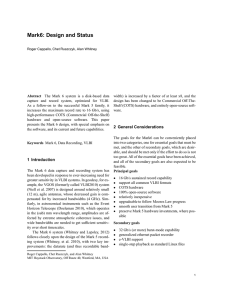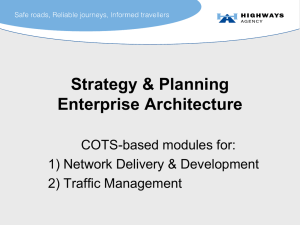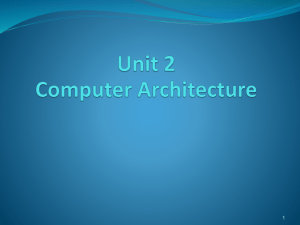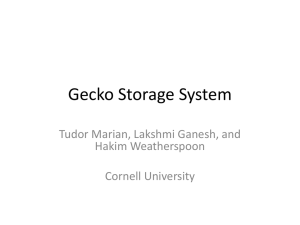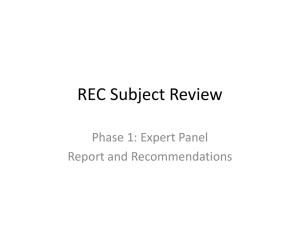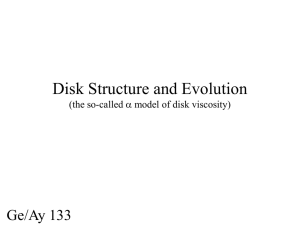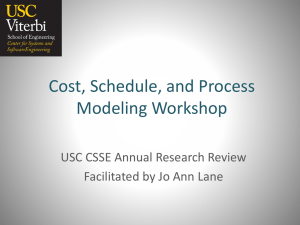Update on Mark 6 VLBI Data System
advertisement
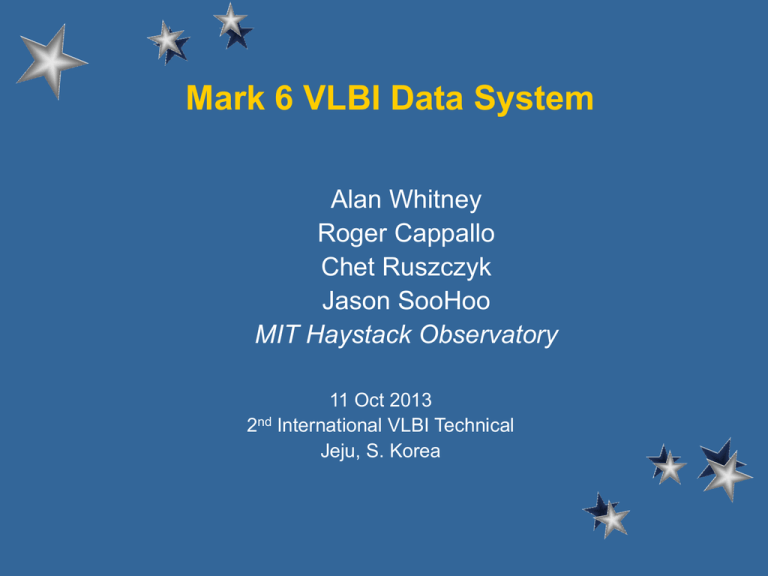
Mark 6 VLBI Data System Alan Whitney Roger Cappallo Chet Ruszczyk Jason SooHoo MIT Haystack Observatory 11 Oct 2013 2nd International VLBI Technical Jeju, S. Korea Why Mark6? - drivers for ever-increasing data rates • -Sensitivity! • -VLBI2010 – enables smaller antennas & shorter scans for better sampling of the atmosphere • -EHT – enables coherent detection of Sgr A* at mm wavelengths (through a fluctuating atmosphere) Mark 6 goals • - 16Gbps sustained record capability • >=32Gbps burst-mode capability • - Support all common VLBI formats • possibly general ethernet packet recorder • - COTS hardware • relatively inexpensive • upgradeable to follow Moore’s Law progress • - 100% open-source software • Linux O/S • Other considerations • playback as standard Linux files • e-VLBI support • smooth user transition from Mark 5 • preserve Mk5 hardware investments, where possible Mark 6 Physical Layout 8 monitor LEDs (one per disk) Module-front-panel connectors for two standard SAS2 cables 1 2 Mark 5/6 enclosure Power supply Chassis backplane kit Data-electronics hardware 5U 1U System chassis (supports 8Gbps by itself) 1 3 2 3 Retractable cable panel 4 4 (for easy management of eSATA data cables) Expansion chassis (needed for 16Gbps) Mark 5/6 enclosure Power supply Chassis backplane kit 4 Mark 6 hardware High-speed data connections to module front-panel via two standard SAS cables Existing Mark 5 chassis is upgradeable to Mark 6 New chassis backplanes for disk power management Cable-management panel (unused cables retract into panel) Existing Mark 5 SATA disk modules are upgradeable to Mark 6 (new backplane and front panel) 5 Mark6 block diagram c-plane l l l l l -control plane -author: Chet Ruszczyk -written in python -interface to user (e.g. field system) – VSI-S and XML control/monitor -responsible for high-level functions – -disk module management l l creating mounting & unmounting – -scan-based recording – -status, error-checking, etc. dplane -data plane -author: Roger Cappallo l -written in C l -implements the high-speed data flow l -input from NIC’s l -output to disks within mk6 modules l -manages: – ▪ start and stop of data flow via packet inspection – ▪ organization of data into files addition of metadata to files l l dplane block diagram dplane - Technical Highlights ▪ pf_ring used for high-speed packet buffering l ▪ efficient use of multiple cores – based on # of available cores – ▪ smp affinity of IRQ’s – ▪ thread binding to cores ▪ most of physical RAM (up to 64-128GB) used for large ring buffers and locked in – ▪ one large ring buffer per stream – ▪ can be changed dynamically from 1 to 4 streams l dplane – file modes scatter mode l ▪ ~10 MB blocks scattered to files resident on different disks l – ▪ prepended block# for ease of reassembly – ▪ uses faster disks to keep up with flow, but balances disk usage as much as possible – ▪ resiliet to l standalone program gather – ▪ efficiently writes data in correct order to single file – ▪ not necessary for single-file (RAID) mode – ▪ front end merging software planned for difx RAID mode l data written to single file – ▪ typically on a RAID array – ▪ good mode for single module of SSD’s Mark 6 data hardware ASRock X79 Champion LGA 2011 Intel X79 motherboard 64GB DDR3 SDRAM 2400 2 x Myricom 10G-PCIE2-8B2-2C 10GE NIC LSI 9201-16E Host Bus Adapter Mark 6 14 Additional Features l ▪ capture to ring buffers is kept separate from file writing l – ▪ helps to facilitate e-VLBI ▪ FIFO design decouples writing from capturing (e.g. keep writing during slew) l ▪ option to conver mk5b format packets “on the fly” into vdif packets l ▪ all Mk6 software is open source for the community l ▪ Mk6 electronics hardware is non-proprietary & openly published Timeline – -Feb 2013: bistatic radar observations of asteroid DA14 recorded at Westford l continuous 8 Gb/s on 2 modules – -Mar 2013: VLBI2010 stand-alone testing – -Sep/Oct 2013: delivery of eight Mark 6 systems (5 - ALMA VLBI; 3 – VGOS) – -Sep/Oct 2013: Developing Mark 6 interfacing software for DiFX correlator; completing standalone self-test; complete documentation Proof of Concept Experiment l l l -done with prototype software (v.0)-June 2012 -Westford – GGAO -technical details – VDIF format – 16 Gb/s onto 32 disks – 4 GHz bandwidth on the sky – dual polarization with 2 GHz IF’s – processed as four 512 MHz channels Recent progress l l l l l l l l continuous 16Gbps error-free operation onto 32 disks using ‘scatter’ file system ▪ ‘scatter’ file writing upgraded to support writing operations as high as 31 Gbps onto 32 disks ▪ ‘gather’ file-reading software reconstructs data written in ‘scatter’ mode ▪ FUSE front-end for file reading hides ‘gather’ operation ▪ testing of high-level interface software ▪ long duration simulated experiment usage ▪ tests with SSD-equipped Mark 6 modules ▪ Still to be done: FS support ▪ VLBI Support Forum at <vlbi.org> Mark 6 availability • Several options: – Purchase new Mark 6 system from Conduant (~US$13k with 64GB RAM memory, no disk modules) – Upgrade existing Mark 5 system (either yourself or with kit from Conduant) – Upgrade Mark 5 SATA-modules (with upgrade kits from Conduant) – Purchase Mark 6 modules (with or without disks) Contact Greg Lynott of Conduant greg@conduant.com 21 Mark 5 SATA Drive Module Upgrade to Mark 6 New Front Panel Front Panel Connectors for two eSATA cables 8x LED (1 per drive) Re-use Handle from old Module Cooling slots New Latch provided (pre-installed on new Panel) New PCB and power connector Rear Panel Easily removable disks 22 Recording-rate capability vs time 100 Mark 7? COTS Disk Mark 6 Projection 10 Mark 5C sk i D Mark 5B+ 1 Mark 5A Mark 4 VLBA Mark 3 Gbps 0.1 p Ta e 0.01 Mark 2 mostly COTS 0.001 Mark 1 COTS 0.0001 1960 1970 1980 1990 2000 2010 2020 23 Recording-rate cost vs. time 105 Mark 1 COTS 104 Mark 2 mostly COTS 103 Ta p e Mark 3 VLBA Mark 4 k$/Gbps 102 10 sk Di Mark 5A Mark 5B+ Mark 5C Mark 6 1 COTS Disk Projection Mark 7? 0.1 1960 1970 1980 1990 2000 2010 2020 24 Questions?

